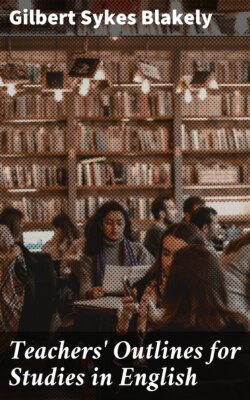Читать книгу Teachers' Outlines for Studies in English - Gilbert Sykes Blakely - Страница 14
На сайте Литреса книга снята с продажи.
III. Study of the Book as a Whole
ОглавлениеSetting and Situation.—Does Cranford seem like a real place? Give reasons for your answer.
When are the events related supposed to have taken place?
Why does Mrs. Gaskell pay so little attention to the details of time and place?
Could the scene of this story be changed to some other place and time without difficulty? Give reasons. Compare Cranford with some place that you know in respect to the poverty, aristocracy, social etiquette, employments, and peculiar ways of the people.
Plot.—What relation does Chapter I bear to the rest of the book? Are there suggestions in it that make you expectant of what is to come in the ensuing chapters?
What connection has Chapter II with the preceding chapter? with the following?
Are Chapters III and IV connected? Are they connected with what follows?
Group the remaining chapters to show which belong together.
How many separate stories do you find with no connection except for the presence of the same characters?
We are told that a good story has a beginning, a middle, and an end. What seems to be lacking in Cranford?
If we were to consider as complete stories the incident of Miss Matty's love affair or of Poor Peter, should we find the same lack?
Characters.—What are the chief motives that prompted the Cranford ladies to do the things that they did, and to do them in the way they did?
How did Captain Brown differ from them in the motives that prompted his actions?
Show how the incident of Miss Jenkins's argument with Captain Brown on the relative merits of Mr. Boz and Dr. Johnson, illustrates one side of Miss Jenkins's character. What is her other side? Illustrate. Compare Miss Matty and her sister to show the strength and weakness of each. What was there in Miss Matty that made the other ladies help her so generously in her trouble?
What sort of woman was Mrs. Jamieson? Were her neighbors blind to her faults? Why did they treat her as they did? Do you think they were insincere?
What other characters in the story have a distinct personality?
Interpretation.—What purpose do you think the author had in writing this book?
From this story, what would you judge were her ideas on sincerity? on the treatment of one's neighbors? on conformity to custom? on social rank? and on other matters of everyday life?
Method of Narration.—Who tells the story?
Does the narrator tell us only of the things that she sees and hears, or of other things as well? How is it in Ivanhoe? Would the story have to be changed essentially if it were told by Miss Matty, Miss Pole, or some other of the characters? Give your reasons.
Has Mrs. Gaskell succeeded in avoiding the awkwardness in the use of "I" so common in stories told in the first person? If so, how? Compare it in this respect with one of your own narratives in the first person.
Point out, if you can, some ways in which the author has made her dialogues smooth and natural. Compare with one of your own.
Style.—Note a few of the most humorous passages; of the most pathetic. In the humorous passages is the author laughing at her characters, or laughing with them? Compare in this respect her treatment of Mrs. Jamieson, Miss Barker, and Miss Pole with Scott's treatment of Prior Aymer, Friar Tuck, and Athelstane.
The Life and Character of the Author.—What facts do we know of Mrs. Gaskell's girlhood? her education? her married life? her great sorrow? her first literary success? her acquaintance with the literary men of her day? the regard of her neighbors for her?
Comparison.—Does the value of this book lie in its setting? in its plot? in its characters? in its style? in its teaching? or in all of these factors?
Compare Cranford in respect to each of the above topics with the other novels that you have studied.
